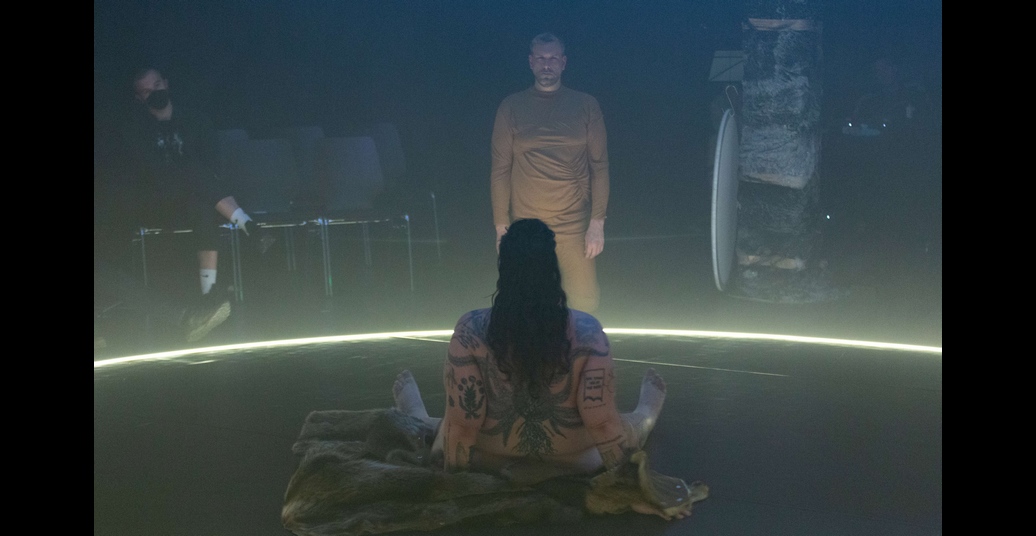Liz Rosenfeld’s “URSA-X”, playing in the fourth and final installment of the spring festival series Queer Darlings at Sophiensæle from 20-23 April 2023, is a meditation on the hole at all scales, from the microscopic to the planetary.
When I enter the Sophiensæle’s Hochzeitsaal with the rest of the audience, two figures are already at the center of the playing space, surrounded on all sides by audience seating. They lounge on a black fabric circle, a mound of fur between them. They are talking, inaudible and intimate. A thin ring of light encircles the whole picture. It takes me a while to notice that the slow dimming and brightening of the light is repeating, making the space seem to inhale and exhale. As the figures (Liz Rosenfeld, R. Justin Hunt) pull on black latex gloves and begin to assemble the piled fur into a kind of robe (costume design: Marquet K. Lee), a voiceover—part calming flight attendant, part narrator of a space documentary—begins to speak. It’s a sort of orientation to the world we’ve entered, which the voice refers to as a hole; through this orientation all sorts of expectations are set, blurring the distinction between accessibility and dramaturgical structure so that it begins to seem absurd to think of them separately anyway (accessibility dramaturgy: Noa Winter, dramaturgy: An*dre Neely). The beginning, which is incidentally also the end, narrates and shapes us (audience, Liz, Justin, text, technicians, story, the bearskin mantle that can be dismantled) as co-dwellers of the hole, “all of us in here together for as long as it took until we felt the sides.”
“URSA-X” is structured of a series of scenes/holes within the larger hole, each announced as it begins with text projected on the crinkled walls. The scenes/holes are occupied by holey themes, also announced by projected text. For example, hole 1: holes for a beginning. Hole 3: peripheries, edges, hidden stories. Hole 6: holes as method. Hole 7: holes in the action, empty places in the telling. Surely I’m leaving holes. After all, both holes and scenes are numbered but the numbers don’t match. The hole numbers skip around. The scene numbers seem to be linear but looking back at my notes, there’s a hole where Scene 6 and Scene 7 should be. But maybe I missed them: there is a lot happening in this hole and, anyway, as the text (Johanna Linsley) and performer-creators remind us regularly and in different ways, a hole is not what it is filled with nor is it its boundaries.
What is it? The work of “URSA-X” is to unfurl some ideas here in front of us and around us, to let them echo in this carved-out hole. It performs a collage of holes. We rove in scale from the planetary to the microscopic. We plumb bodily cavities and their accompanying desires from sex to food. The cavelike performance space is a hole, contains holes, and just before Scene 5/Hole 2, Liz and Justin poke parts of its crinkled black walls full of holes, letting light shine through (stage design: Sadie Weis, light design: Joseph Wegmann).
In true collage form, much of “URSA-X” is a cacophony of input and images and references and information, the more so because it’s so carefully thought out for differing abilities and disabilities which at times leads to a Happenings-like dramaturgy where you’ve got to lean in to the fact that it is simply impossible to take everything in, and that in fact you aren’t meant to. Justin and Liz’s improvisation accompanied by wall text explaining why this scene is impossible to supertitle is a prime example of this. If you are a person both hearing and sighted like me, you can pay attention to the wall text which here becomes a character, or you can pay attention to the improv. Try to do both, and you miss the comedy, the fun.
Such choices regarding attention are always part of spectatorship in live performance on some scale, and I accepted them as part of sensing my way through the hole. But I appreciated, too, calmer and stiller holes. Hole 7 (holes in the action) has Liz wearing the Ursa mantle at center. They rotate their body slowly in a circle, and as they perform these rotations they also rotate individual body parts: hips, then fingers, then wrists, stomach. They take an index finger and circle their heart. An unfillable hole? Or a hole in the story? We might all need to stay longer in the hole to find out.
“URSA-X” by Liz Rosenfeld is shown on 20, 21 and 23 April 2023 at Sophiensæle.
The performance is part of the festival Queer Darlings 4 (14. – 23.4.2023). You find the full program and ticket info at sophiensaele.com.




